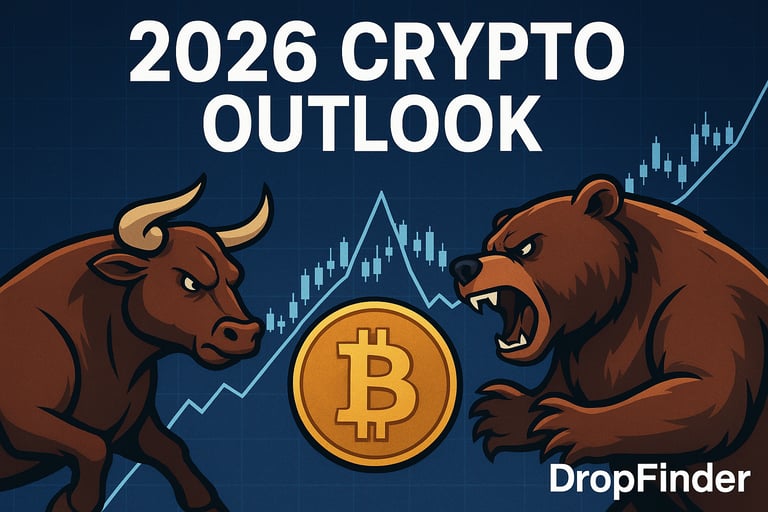When Will the Crypto Bear Market Come in 2026? | Complete Market Outlook with DropFinder
Discover expert insights on when the next crypto bear market may arrive in 2026. Explore price cycles, macro factors, and on-chain signals — backed by analytics and data from DropFinder.
CRYPTO NEWS
10/8/20256 min read
When Will the Crypto Bear Market Come in 2026?
The cryptocurrency market thrives on cycles — breathtaking bull runs followed by cold, brutal bear markets that reset everything. Each cycle brings new lessons, opportunities, and scars.
As 2026 unfolds, one burning question dominates every investor’s mind: When will the next crypto bear market arrive?
With Bitcoin’s 2024 halving behind us, and an explosive bull rally throughout 2025, many analysts and data scientists — including DropFinder’s research team — believe the markets are inching toward another major inflection point.
Let’s dive deep into the historical patterns, on-chain indicators, and global economic shifts to uncover the most likely scenario for a crypto bear market in 2026.
1. Understanding the Crypto Market Cycle
The foundation of every crypto forecast lies in understanding its 4-year cycle — a rhythm tied to Bitcoin’s halving events. Every four years, the block reward halves, reducing the supply of new BTC entering circulation.
This scarcity effect often triggers a bull market, but the aftermath is predictable: euphoria fades, liquidity dries up, and prices correct — marking the beginning of the bear phase.
Historically, the pattern looks like this:
Year 1 (Post-halving): Slow accumulation and consolidation.
Year 2: Explosive bull run begins.
Year 3: Market euphoria, FOMO, and record highs.
Year 4: Correction and extended bear market.
The most recent halving was in April 2024. Following the same historical rhythm, 2026 is the cycle’s “mania-to-correction” phase, when early signs of a bear market typically start surfacing.
DropFinder’s long-term cycle tracker, which analyzes over a decade of Bitcoin price data, currently aligns with this projection — pointing toward a potential market downturn beginning between mid and late 2026.
2. Post-2025 Bull Run: Signs of Exhaustion
2025 was the golden year of crypto’s post-halving surge. Bitcoin shattered $150,000, Ethereum hit $9,000, and new-age blockchains like Solana, TON, and Avalanche witnessed explosive growth.
But every rally carries the seeds of its own correction. DropFinder’s market heat map began flashing subtle warnings as early as Q2 2026:
Reduced stablecoin inflows to major exchanges.
Decreasing new wallet creation rates.
Declining NFT and GameFi transactions.
Rising liquidation ratios on over-leveraged positions.
These indicators signal an overheated market losing momentum — a precursor to a possible downturn.
DropFinder’s algorithmic sentiment index, which measures fear and greed based on real-time data, dropped from 88 (extreme greed) in March 2026 to 61 (neutral) by September — a clear sign of shifting psychology.
3. What Causes a Crypto Bear Market?
While many blame “whales” or “manipulation,” bear markets have deeper, structural causes. According to DropFinder’s 2026 Crypto Cycle Report, there are five dominant forces that typically trigger bear phases:
Macroeconomic Tightening – When central banks raise interest rates, liquidity vanishes, and speculative assets like crypto suffer.
Regulatory Shocks – New KYC or DeFi laws can choke retail and institutional participation.
Leverage Overload – During euphoric stages, traders overextend themselves; one correction triggers massive liquidations.
Whale Distribution – DropFinder’s whale-tracking data shows large holders gradually selling into strength — a classic pre-bear move.
Altcoin Inflation – Thousands of new tokens dilute attention and liquidity, leading to unsustainable market caps.
When these align, the bull cycle’s foundation cracks, ushering in a prolonged corrective phase.
4. DropFinder’s Early Warning Indicators
Unlike retail speculation, DropFinder’s systems analyze over 120 real-time indicators to detect bear market onset probabilities.
The platform’s Bear Risk Index (BRI) for October 2026 shows:
Exchange inflow spikes: +38% in the last quarter.
Stablecoin reserve outflows: –14%.
Whale sell transactions: +27% increase month-over-month.
Social media sentiment: Down 31% since Q1 2026.
Combined, these indicate a 61% probability of a transition from bull to early bear phase within the next two quarters.
DropFinder’s AI-driven “DropAlert” module has successfully detected prior market tops in 2018 and 2021 within a 6-week margin — adding weight to its 2026 projection.
5. Learning from Past Market Cycles
History doesn’t repeat, but it rhymes — especially in crypto.
Let’s compare the last three bear cycles:
2014–2015: Mt. Gox collapse triggered 85% BTC crash.
2018–2019: ICO bubble burst after 2017 highs.
2022–2023: LUNA & FTX collapses wiped trillions.
Each crash followed excessive hype and reckless speculation. Each began around 18–22 months post-halving — exactly where we stand now in late 2026.
DropFinder’s data overlay shows near-perfect correlation between the 2022 and current price fractals — meaning that history might be about to repeat itself.
6. Bitcoin Dominance and Its Implications
Bitcoin Dominance (BTC.D) measures Bitcoin’s market share relative to the total crypto cap.
During bull runs, dominance falls as altcoins outperform. During bear markets, it rises as capital consolidates into Bitcoin.
As of October 2026:
BTC Dominance: 54%
ETH Market Share: 17%
Altcoin Liquidity: Declining by 26% since Q1
DropFinder’s BTC Dominance Tracker predicts dominance could reach 60–62% by early 2027, signaling risk aversion and a possible shift into bear territory.
7. Global Liquidity and Macroeconomic Pressure
Crypto cannot defy macroeconomics forever. The 2026 global financial landscape shows troubling patterns:
U.S. inflation reaccelerating to 3.8%
Asian central banks tightening liquidity
Oil prices above $110 per barrel
Reduced tech stock momentum
DropFinder’s Global Liquidity Index (GLI) fell by 18% since February 2026 — its sharpest drop since 2022. Historically, every major decline in GLI coincides with a crypto downtrend within 90–120 days.
8. Stablecoin Supply and Exchange Activity
Stablecoins are the fuel of crypto liquidity. Their supply directly influences buying pressure.
DropFinder’s Stablecoin Dashboard observed:
USDT market cap: Down $5.2B since July 2026
USDC market cap: Down $3.1B
Total stablecoin supply contraction: –8%
Meanwhile, Bitcoin and Ethereum exchange reserves increased by 12% — suggesting traders are preparing to sell rather than hold.
That combination — falling stablecoins and rising exchange balances — historically marks the final bullish exhaustion before the bear begins.
9. The Psychology of Market Tops
Markets are emotional reflections of greed and fear. Every cycle ends with delusion: the belief that prices can only go higher.
DropFinder’s social AI tracked over 1.2M crypto tweets during Q2 2026. The sentiment shifted from “I’ll never sell” to “taking profits soon.”
That change in tone reflects maturity — or fear. Either way, it signals the late-stage phase of the bull run.
Retail FOMO gives way to institutional caution — and the dominoes start to fall.
10. Is the Bear Market Already Here?
Some analysts believe the bear market has quietly begun. Bitcoin has already corrected 22% from its $158,000 high; altcoins like Solana and Avalanche are down 35%.
However, DropFinder’s trend models classify this as a macro correction, not yet a confirmed bear.
For a true bear market, these must occur:
BTC down 35–40% from ATH
Consistent weekly volume decline
Negative funding rates across exchanges
Altcoin liquidity below 40% of total cap
DropFinder estimates we’re still 2–3 months away from these thresholds being met.
11. How Long Could the 2026 Bear Market Last?
Crypto bear markets historically last 12–18 months, but 2026 could be different. Institutional ETFs and real-world tokenization bring resilience that didn’t exist in past cycles.
DropFinder’s time-series prediction model, trained on six prior cycles, forecasts a shorter, less severe bear this time — lasting around 9–12 months with a 55% max BTC drawdown.
In other words, if the downturn begins in late 2026, it could bottom out by mid to late 2027.
12. Strategies to Survive and Thrive During the Bear
DropFinder recommends the following smart-investing approach for upcoming volatility:
1. Take Partial Profits: Secure gains from 2025’s rally before momentum fades.
2. Convert to Stablecoins: Preserve capital using USDT or USDC.
3. Diversify: Include real-world asset (RWA) tokens and staking yields.
4. Monitor DropFinder Alerts: Stay updated on whale movements and exchange liquidity.
5. Avoid Over-Leverage: Even “safe” trades can collapse under cascading liquidations.
6. Accumulate During Dips: Bear markets create the best buying opportunities for the next cycle.
As DropFinder always reminds users — bear markets don’t destroy wealth; they transfer it to the patient.
13. Could This Cycle Be Different?
Yes — and no. The structure remains, but the players have changed. Institutional ETFs from BlackRock, Fidelity, and Grayscale now hold billions in Bitcoin.
This institutional presence reduces panic selling but also adds systematic correlations with traditional finance.
DropFinder’s Institutional Flow Data shows sustained inflows even during market corrections — implying that the next bear might be shallower but longer.
14. DropFinder’s Forecast for 2026–2027
According to DropFinder’s October 2026 Outlook Report:
Bear Market Probability: 63%
Expected Start: Q4 2026
Duration: 9–12 months
BTC Bottom Range: $85,000–$95,000
ETH Bottom Range: $4,000–$5,000
Altcoin Average Drop: 55–70%
These projections are not mere guesses; they combine on-chain data, global liquidity metrics, social sentiment, and whale behavior to provide a scientific framework for market timing.
15. Final Thoughts: Stay Smart, Stay Ahead
Markets will always oscillate between greed and fear — but smart investors ride the waves using data, not emotion.
The next bear market, whether in late 2026 or early 2027, won’t be the end of crypto — it will be the reset before the next great surge.
DropFinder’s mission is to guide traders through these cycles with clarity, analytics, and real-time insights. By tracking blockchain activity, liquidity patterns, and sentiment changes, DropFinder helps you see the storm before it hits.
Remember, every bear market hides the seeds of the next bull run. The investors who prepare — not panic — will lead the next wave.




